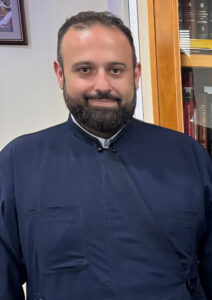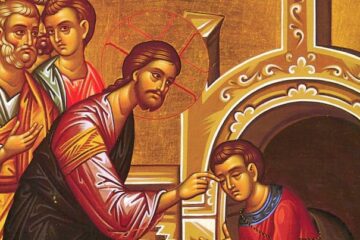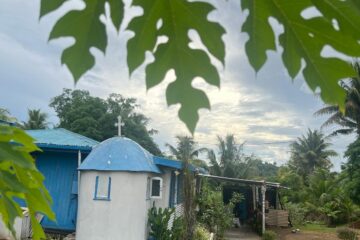By Fr. Michael Psaromatis
Greek Orthodox Archdiocese of Australia
The Gospel account in Matthew 14:22–34 places us on the Sea of Galilee, where the Lord teaches us the power of the steady gaze. After the miraculous feeding of the five thousand, Christ sends His disciples ahead by boat while He withdraws to the mountain to pray. As night falls, the wind rises, and the sea grows restless. The boat is “tossed by the waves, for the wind was contrary” (Matthew 14:24). In the fourth watch of the night, between three o’clock and six o’clock in the morning when human strength is most spent, Christ comes to them, walking on the water. The disciples are terrified, mistaking Him for a ghost. But His voice cuts through their fear: “Take courage; it is I; do not be afraid” (Matthew 14:27). In Greek, ego eimi, “I AM,” echoes the divine name revealed to Moses at the burning bush (Exodus 3:14). St Cyril of Alexandria notes that this is not mere reassurance but a revelation: the One who treads the waves is the Creator Himself.
Hearing the Lord’s voice, Peter cannot remain in the boat. “Lord, if it is You, command me to come to You on the water” (Matthew 14:28). Christ gives a single word, “Come” (Matthew 14:29). That one word is enough to draw Peter out onto the waves. For a moment, he walks in the miraculous freedom of faith. Yet when he “sees the wind,” fear grips him, and he begins to sink. St John Chrysostom comments that it was not the wind that defeated Peter, but his doubt, his shift of focus from Christ to the danger around him (Homily 50 on Matthew). This is the lesson of the gaze that saves. We may begin a spiritual effort such as prayer, fasting, or an act of service with conviction, but when the winds of difficulty, fatigue, or opposition rise, our eyes turn to the problem instead of the One who called us. In our modern age, those winds blow strongly. Twenty four hour news feeds magnify fear. Social media fosters comparison and envy. Economic pressures stir anxiety. These distractions draw our gaze from Christ to the storm. Peter, however, does the one thing necessary: he cries out, “Lord, save me!” (Matthew 14:30). St Augustine says, “If Peter had been silent, he would have perished; but by calling out, he took hold of the Word” (Sermon 76). It is not eloquence that moves the hand of Christ, but the honesty of trust. And the Lord’s response is immediate. He stretches out His hand to lift Peter from the water (Matthew 14:31).
The reading from 1 Corinthians 3:9–17 offers another image. St Paul warns that “no other foundation can anyone lay than that which is laid, which is Jesus Christ” (1 Corinthians 3:11). A life built on comfort, popularity, or worldly success will collapse in the storm, as the Lord Himself teaches in the parable of the house built on sand (Matthew 7:24–27). The Fathers are clear: the foundation is strengthened through prayer, which anchors our hearts in God; repentance, which removes the rot of sin; the Eucharist, which unites us to Christ’s life; and works of mercy, which give faith its living expression. St Isaac the Syrian writes, “Without constant prayer, the soul is a ship without a rudder” (Ascetical Homilies). To build on Christ means to root every part of life in Him, including our identity, decisions, hopes, and values.
From the earliest centuries, the boat on the stormy sea has been understood as an image of the Church in the world. Origen observes that “the boat is tossed because the Church is shaken by the storms of persecution, heresy, and the temptations of the world” (Commentary on Matthew). Christ may sometimes seem distant, but He is never absent, and His word to His Church is always the same: “Do not be afraid” (Matthew 14:27). In every generation there has been a temptation to leave the boat in favour of a solitary spirituality or a faith lived apart from the gathered Body. Yet the Orthodox tradition teaches that salvation is lived out in communion, not in isolation.
From the beginning, God has called a people, not a scattering of individuals, to worship and to witness (Exodus 19:5–6; 1 Peter 2:9). Christ gathers His disciples, forms them into His Body, and breathes the Spirit upon them together (John 20:22). St Paul does not speak of many separate Christians but of one Body with many members, each alive only when united to the whole (1 Corinthians 12:12–27), just as a branch has life only when connected to the vine (John 15:4–6). St Cyprian of Carthage said, “No one can have God as his Father who does not have the Church as his Mother” (On the Unity of the Church), comparing the Church to Noah’s ark, for all who were saved from the flood were within it. To abandon the ark was to face certain destruction. St John Chrysostom warns that you cannot pray at home as you can in the Church, where many voices rise together as from one great heart (Homily 3 on Eutropius). For him, corporate prayer and worship are not optional extras but the very lifeblood of the soul. St Ignatius of Antioch, on his way to martyrdom, urged the faithful to remain united with the bishop, presbyters, and deacons, for “wherever the bishop appears, there let the people be; just as wherever Jesus Christ is, there is the Catholic Church” (Smyrneans 8).
To step out of the boat of the Church in search of a purely private faith is to face the winds and waves without the ark Christ has given us. Private devotion is vital, but it is incomplete without the shared worship, sacramental life, and mutual bearing of burdens that belong to the Body of Christ (Galatians 6:2). As St Basil the Great reminds us, “The hand of the solitary Christian is weak; but the hands of many knit together are strong” (Long Rules, Question 7). In the boat we may still feel the storm, but we are not alone, and Christ is in our midst (Matthew 18:20).
This truth is reflected vividly in the life of St Lawrence, the Holy Archdeacon of Rome, commemorated on August 10. In the year 258, during the persecution under Emperor Valerian, Lawrence was entrusted with the care of the poor and the distribution of the Church’s alms. When the pagan prefect demanded that he hand over the Church’s treasures, Lawrence assembled the poor, the widows, and the orphans, declaring, “These are the treasures of the Church” (Acts of the Martyrdom of St Lawrence). For this, he was condemned to a slow martyrdom on a gridiron. Even as the flames consumed him, he prayed for his persecutors. His life bridges the Gospel and the Epistle: like Peter, he stepped into danger with eyes fixed on Christ; like the wise builder, his life was laid on the foundation of love for God and neighbour (Matthew 22:37–39). In an age that measures worth by wealth, status, and self preservation, Lawrence reminds us that every human being is a treasure in God’s Kingdom (James 2:5). Peter was safe as long as his gaze rested on the Lord. St Lawrence stood unshaken in the flames because his heart never turned from the face of Christ. Fear may distract us, temptation may beckon, and the world may roar, but the saving hand of the Lord is always within reach of those who look to Him. Let us, then, make the prayer of Peter our own: “Lord, save me” (Matthew 14:30). Let us learn the discipline of the steady gaze through prayer, Scripture, the Mysteries, repentance, and acts of mercy, so that our eyes remain on the One who calms the sea. For it is not the absence of waves that saves us, but the presence of Christ before our eyes. May we walk on the waters of trial, stand firm in the fires of testing, and finish our course with eyes fixed on the Lord, for in Him is the gaze that saves.
*****
 Fr Michael is a priest of the Greek Orthodox Archdiocese of Australia. He has studied Information Technology, Modern Greek, and Theology at Flinders University. With a deep love for music, theology, and arts Fr Michael brings a dynamism to his ministry.
Fr Michael is a priest of the Greek Orthodox Archdiocese of Australia. He has studied Information Technology, Modern Greek, and Theology at Flinders University. With a deep love for music, theology, and arts Fr Michael brings a dynamism to his ministry.
His 13 year ministry has included service in aged care, the youth, regional communities, and meeting the needs of busy Parishes with Presvytera Stavroula.
Fr Michael is also actively involved in Orthodox missionary outreach in the Pacific, particularly in Fiji. He has spent time in the region serving liturgy, engaging with local communities, and working towards the development of the mission.
He is currently serving at the Parish of St Dimitrios, Salisbury, in South Australia.



0 Comments